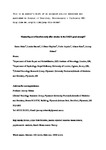Measuring arm function early after stroke: is the DASH good enough?
| dc.contributor.author | Baker, K | |
| dc.contributor.author | Barrett, L | |
| dc.contributor.author | Playford, ED | |
| dc.contributor.author | Aspden, T | |
| dc.contributor.author | Riazi, A | |
| dc.contributor.author | Hobart, J | |
| dc.date.accessioned | 2016-09-28T09:29:15Z | |
| dc.date.available | 2016-09-28T09:29:15Z | |
| dc.date.issued | 2016-06-01 | |
| dc.identifier.issn | 0022-3050 | |
| dc.identifier.issn | 1468-330X | |
| dc.identifier.uri | http://hdl.handle.net/10026.1/5490 | |
| dc.description.abstract |
OBJECTIVE: Despite a growing call to use patient-reported outcomes in clinical research, few are available for measuring upper limb function post-stroke. We examined the Disabilities of the Arm, Shoulder and Hand (DASH) to evaluate its measurement performance in acute stroke. In doing so, we compared results from traditional and modern psychometric methods. METHODS: 172 people with acute stroke completed the DASH. Those with upper limb impairments completed the DASH again at 6 weeks (n=99). Data (n=271) were analysed using two psychometric paradigms: traditional psychometric (Classical Test Theory, CTT) analyses examined data completeness, scaling assumptions, targeting, reliability and responsiveness; Rasch Measurement Theory (RMT) analyses examined scale-to-sample targeting, scale performance and person measurement. RESULTS: CTT analyses implied the DASH was psychometrically robust in this sample. Data completeness was high, criteria for scaling assumptions were satisfied (item-total correlations 0.55-0.95), targeting was good, internal consistency reliability was high (Cronbach's α=0.99) and responsiveness was clinically moderate (effect size=0.51). However, RMT analyses identified important limitations: scale-to-sample targeting was suboptimal, 4 items had disordered response category thresholds, 16 items exhibited misfit, 3 pairs of items had high residual correlations (>0.60) and 84 person fit residuals exceeded the recommended range. CONCLUSIONS: RMT methods identified limitations missed by CTT and indicate areas for improvement of the DASH as an upper limb measure for acute stroke. Findings, similar to those identified in multiple sclerosis, highlight the need for scales to have strong conceptual underpinnings, with their development and modification guided by sophisticated psychometric methods. | |
| dc.format.extent | 604-610 | |
| dc.format.medium | Print-Electronic | |
| dc.language | en | |
| dc.language.iso | en | |
| dc.publisher | BMJ | |
| dc.subject | Adolescent | |
| dc.subject | Adult | |
| dc.subject | Aged | |
| dc.subject | Arm | |
| dc.subject | Disability Evaluation | |
| dc.subject | Female | |
| dc.subject | Follow-Up Studies | |
| dc.subject | Hemiplegia | |
| dc.subject | Humans | |
| dc.subject | Male | |
| dc.subject | Middle Aged | |
| dc.subject | Outcome Assessment, Health Care | |
| dc.subject | Psychometrics | |
| dc.subject | Reproducibility of Results | |
| dc.subject | Stroke | |
| dc.subject | Young Adult | |
| dc.title | Measuring arm function early after stroke: is the DASH good enough? | |
| dc.type | journal-article | |
| dc.type | Journal Article | |
| plymouth.author-url | https://www.webofscience.com/api/gateway?GWVersion=2&SrcApp=PARTNER_APP&SrcAuth=LinksAMR&KeyUT=WOS:000376686100006&DestLinkType=FullRecord&DestApp=ALL_WOS&UsrCustomerID=11bb513d99f797142bcfeffcc58ea008 | |
| plymouth.issue | 6 | |
| plymouth.volume | 87 | |
| plymouth.publication-status | Published | |
| plymouth.journal | Journal of Neurology, Neurosurgery & Psychiatry | |
| dc.identifier.doi | 10.1136/jnnp-2015-310557 | |
| plymouth.organisational-group | /Plymouth | |
| plymouth.organisational-group | /Plymouth/Faculty of Health | |
| plymouth.organisational-group | /Plymouth/Faculty of Health/Peninsula Medical School | |
| plymouth.organisational-group | /Plymouth/REF 2021 Researchers by UoA | |
| plymouth.organisational-group | /Plymouth/REF 2021 Researchers by UoA/UoA03 Allied Health Professions, Dentistry, Nursing and Pharmacy | |
| plymouth.organisational-group | /Plymouth/Research Groups | |
| plymouth.organisational-group | /Plymouth/Research Groups/Institute of Translational and Stratified Medicine (ITSMED) | |
| plymouth.organisational-group | /Plymouth/Research Groups/Institute of Translational and Stratified Medicine (ITSMED)/CCT&PS | |
| plymouth.organisational-group | /Plymouth/Users by role | |
| plymouth.organisational-group | /Plymouth/Users by role/Academics | |
| dc.publisher.place | England | |
| dcterms.dateAccepted | 2015-06-18 | |
| dc.rights.embargodate | 2017-06-01 | |
| dc.identifier.eissn | 1468-330X | |
| dc.rights.embargoperiod | 12 months | |
| rioxxterms.versionofrecord | 10.1136/jnnp-2015-310557 | |
| rioxxterms.licenseref.uri | http://www.rioxx.net/licenses/under-embargo-all-rights-reserved | |
| rioxxterms.licenseref.startdate | 2016-06-01 | |
| rioxxterms.type | Journal Article/Review |


